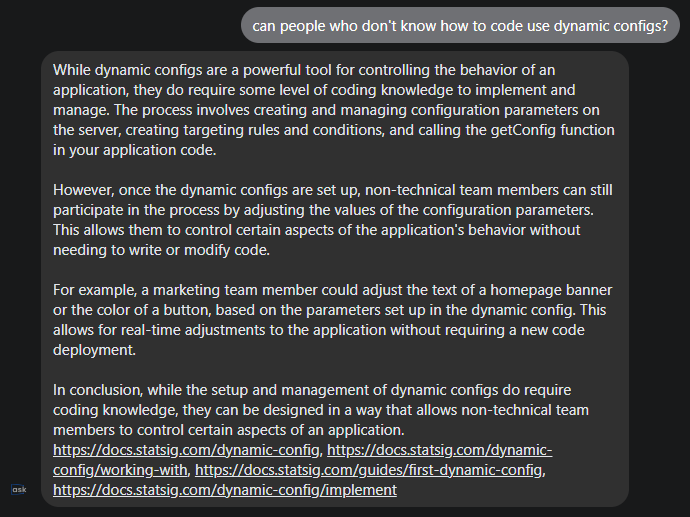
The solutions engineering team that manages a critical part of Statsig’s sales process just became AI-enhanced.
If you’ve requested a demo, asked a technical question, or been active in our Slack community, it’s likely you’re familiar with our solutions engineering team.
Solutions engineers handle the technical side of sales evaluations. (Think product demos, managing proofs of concept, leading software integrations, etc.) Between the highly technical nature of Statsig as a product, and the sheer volume of deals we work with, our solutions engineers have their plates full.
Our head of solutions engineering, Ryan Musser, built AskSE to respond to our growing demands on the solutions engineering team. AskSE is a bot that pulls from our knowledge repository and uses ChatGPT to package technical, security and privacy documentation into usable info for our sales team.
AskSE has allowed us to scale sales activities and self-service items like security questionnaires and one-off technical questions, without needing additional solutions engineer headcount.
Background
AskSE was built on the same documentation that our solutions engineers use to support customers.
It scraped a multitude of content sources, including our technical docs, blogs, security pages, subprocessor information, and more. Once the data was scraped, the entire information library of Statsig was then stored as vectors.
Storing this data as vectors rather than keywords allowed for semantic searching, so concepts can be searched even if specific terms differ slightly. The ability to search for information without knowing nitty gritty details hugely increased accessibility for our non-technical team members.
For example, the term “soc2 type2” on a keyword search might not return any useful information, but the same search on a vector would pull up our “Soc II Type II report” as the closest and most relevant document.
This allows for a more comprehensive retrieval of relevant information, rather than being rigidly tied to a particular term. This means that anyone with a Statsig-related question—whether a seasoned product veteran like a solutions engineer, or a marketer simply looking for the right way to phrase a feature—can easily use AskSE to find the information they’re looking for.

This also means that account executives can self-service simple customer requests, and don’t need to know an exact term to pull relevant information.
AskSE’s architecture
AskSE’s vectors are stored in a Pinecone database, which serves as a repository of all snippets of Statsig knowledge. OpenAI sits on top of this, which digests the vectors into a usable answer for our team.
When a query is initiated within AskSE, it translates the question into a vector, identifying the top 5 entries in the Pinecone database that best matches the query's context. These entries are then passed to ChatGPT.
Finally, ChatGPT processes this information, contextualizes it, and prepares it for usage by repackaging it into a coherent and informative response.
Statsig employees query AskSE through a chrome plugin, as well as direct messaging through our internal communication tools.
Join the Slack community

Applications
Setting up AskSE took Ryan, our Head of Solutions Engineering, around 10 hours.
AskSE was queried 1700+ times in the last 6 months. We estimate the tool saves our company around 10 hours a week, and is especially useful for repetitive and time-consuming tasks like security and infosec questionnaires. Rather than needing to hire additional headcount, we’ve been able to scale our existing team by making our documentation more accessible.
AskSE’s ability to search for context is especially useful in translating lengthy technical documentation into digestible answers.
For example, on a customer call last week, I was asked if we integrate with Cloudflare Workers. I’m not familiar with this tool, and even misspelled it when I asked AskSE “Do we integrate with cloudfare workers?”
The bot returned (in real-time) that we have an outgoing integration that pushes Statsig Configs to Cloudflare KV Projects. Reading our documentation and pulling this context would have easily taken me 10 minutes without the bot, and I would have needed to punt the question on a live customer call.
The future is here
AskSE isn’t a golden ticket, but when layered with other similar AI applications, it allows us to scale the impact of our sales team without needing additional training or hiring.
Our solutions engineers are able to focus on high-value work for our customers, and the account executives are able to knock out repetitive tasks with consistent, information-rich answers.
If you have any questions, don't hesitate to reach out to our sales team and ask them to AskSE it! 😆
Request a demo



